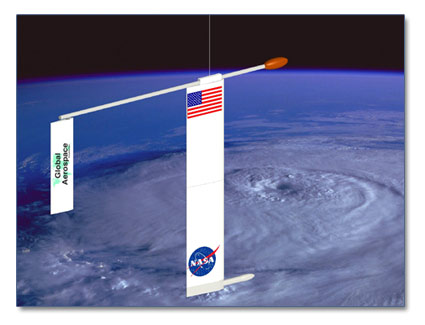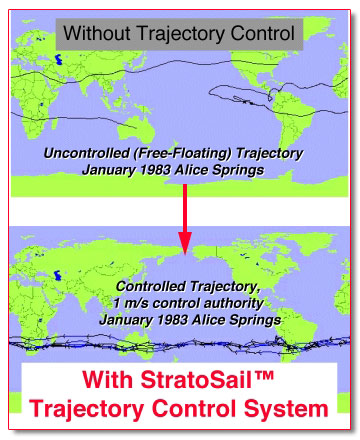How the StratoSail® Balloon Trajectory Control System Works

In the atmosphere, the winds blow at different speeds at different altitudes. Unlike at the surface, the winds almost never stop blowing at the high altitudes used by science balloons that fly in the stratosphere. Free flight balloons drift along at whatever speed the wind is blowing at their operating altitude. These winds, which we can count on to keep blowing, blow at different speeds at different altitudes. We plan to take advantage of these wind differences by hanging our BGS wing as much as 15 km (about 9 miles) below the balloon which will fly about 35 km (22 miles). This places the wing at least 20 km (12 miles) high or still about 10 km (6 miles) above Mount Everest and well above any commercial and most military aircraft.
The wind at the balloon will usually be quite a bit faster than down where the wing is suspended. The wing will be dragged along faster than the wind where the wing is operating. By angling the wing to one side, the wing will pull off to that side. Because this pull is tugging on the tether, the balloon is also dragged off to that side. Of course, the wing can be angled to either side of the flight path.
In comparison with the wind speed, this lateral drift velocity generated by the wing is quite small. This system cannot hold the balloon in a fixed place. But it can influence the flight path so that over several hours, an appreciable change in the final position can be achieved. The winds at these high altitudes tends to be mostly due east or due west depending on season and latitude. In most circumstances, the BGS can overcome the wind’s small drift either northward or southward. Thus, the BGS can keep the balloon always at the same latitude.
Some long duration balloon flights have the potential to go around the world many times. Often they must be cut down early to avoid uncooperative countries, or to be sure that the payload will come down over land rather than ocean. If a BGS is used to keep the balloon at the same latitude, it can return repeatedly to the launch site. This is often the most convenient place to land the balloon payload. Of course, situations can always come up which force an emergency cut-down, but if there is reasonable confidence that the balloon can be controlled, one can wait another twenty days for the balloon to come around to the launch site again. This will tremendously increase the operational flexibility of these long duration balloon flights.
Scientific balloons often fly in the Arctic or Antarctic. In some cases this is simply to avoid danger to inhabited regions. Other times it is because of interesting phenomena, such as the hole in the ozone layer, which may be situated near the poles. It can be an advantage to have continuous sunlight in the summertime. But launching balloons from these remote regions can be very challenging. With a BGS aboard, one can launch from a more temperate site and then direct the balloon to the region of interest. In fact, one could launch in the Northern Hemisphere, command the balloon across the equator and go all the way to the South Pole, and then return back to the vicinity of the launch site. Such a flight would last many months. In fact, with advanced balloon materials, one could consider launching some balloons with the intent of flying them essentially indefinitely. Alternatively, a conventional zero pressure balloon could be launched from McMurdo Station in Antarctica and, by means of a BGS, operate very near the South Pole to minimize diurnal variations that result in reduced altitude variation. A balloon so equipped could be flown back to a landing near McMurdo reducing recovery logistics.

Resources
Web Design & SEO by Bryt Designs in Long Beach, CA